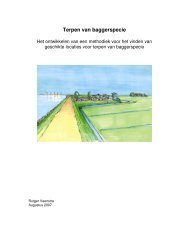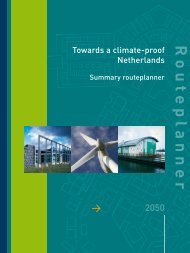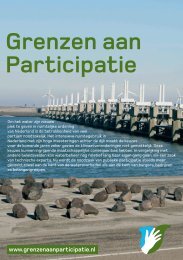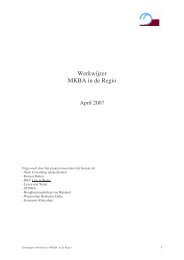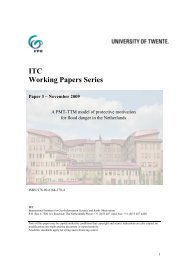Deltas on the move; Making deltas cope with the effects of climate c
Deltas on the move; Making deltas cope with the effects of climate c
Deltas on the move; Making deltas cope with the effects of climate c
- No tags were found...
Create successful ePaper yourself
Turn your PDF publications into a flip-book with our unique Google optimized e-Paper software.
KvR report 001/2006almost completely flooded during flood seas<strong>on</strong>s, and some nutrients and silt reached<strong>the</strong> flood plain. This regular flooding had a major impact in <strong>the</strong> following ways:- making <strong>the</strong> flood plain soil naturally fertile;- desalinizati<strong>on</strong> <strong>of</strong> <strong>the</strong> flood plain;- refreshing <strong>the</strong> water in <strong>the</strong> lakes;- creati<strong>on</strong> <strong>of</strong> natural biotopes for plants and animals.However, <strong>the</strong> capacity <strong>of</strong> <strong>the</strong> deep main river channel was so large that most <strong>of</strong> <strong>the</strong>water, al<strong>on</strong>g <strong>with</strong> most <strong>of</strong> <strong>the</strong> silt and nutrients and all <strong>of</strong> <strong>the</strong> sand, was transporteddirectly to <strong>the</strong> sea. The Romanian part <strong>of</strong> <strong>the</strong> delta is still regularly flooded duringspring floods, but <strong>the</strong> Ukrainian, nor<strong>the</strong>rn part <strong>of</strong> <strong>the</strong> delta receives almost no water,sediments or nutrients since <strong>the</strong> c<strong>on</strong>structi<strong>on</strong> <strong>of</strong> embankments over <strong>the</strong> last 40 years(Figure 7.1, WWF, 2002). This has significant c<strong>on</strong>sequences for several keyprocesses in <strong>the</strong> delta as a whole since 75% <strong>of</strong> <strong>the</strong> water flows through <strong>the</strong> nor<strong>the</strong>rnpart <strong>of</strong> <strong>the</strong> delta:- Slow growth <strong>of</strong> <strong>the</strong> inner parts <strong>of</strong> <strong>the</strong> delta. As much <strong>of</strong> <strong>the</strong> sediment passedthrough <strong>the</strong> delta to <strong>the</strong> sea, <strong>the</strong>re was not much available for building up <strong>the</strong>height <strong>of</strong> <strong>the</strong> delta. These circumstances account for <strong>the</strong> existence <strong>of</strong> <strong>the</strong> veryextensive plains <strong>with</strong> reed beds and lakes in <strong>the</strong> delta. The embankments built inrecent time, secti<strong>on</strong>ing <strong>of</strong>f large parts <strong>of</strong> <strong>the</strong> Ukrainian flood plain and most <strong>of</strong> <strong>the</strong>islands in <strong>the</strong> nor<strong>the</strong>rn distributary, have completely halted <strong>the</strong> growth process.- Filtering <strong>of</strong> <strong>the</strong> river water. When <strong>the</strong> waters <strong>of</strong> <strong>the</strong> Danube reached <strong>the</strong> immensereed beds and lakes <strong>of</strong> <strong>the</strong> vast flood plain over a four-m<strong>on</strong>th period each year, atleast some <strong>of</strong> <strong>the</strong> water was filtered by <strong>the</strong> flood plain: silt particles were re<strong>move</strong>dand nutrients supported <strong>the</strong> luxuriant reed growth. No filtering has taken place in<strong>the</strong> reed beds since <strong>the</strong> c<strong>on</strong>structi<strong>on</strong> <strong>of</strong> embankments.- Formati<strong>on</strong> <strong>of</strong> river banks. During flooding, silt particles in <strong>the</strong> water weredeposited <strong>on</strong> <strong>the</strong> riverbanks and in <strong>the</strong> adjacent stretches <strong>of</strong> reed beds. In <strong>the</strong>present embanked situati<strong>on</strong>, <strong>the</strong>re is virtually no sedimentati<strong>on</strong> except for <strong>the</strong>narrow strips <strong>of</strong> land not encircled by dikes.- Development <strong>of</strong> islands. Islands in <strong>the</strong> river developed in <strong>the</strong> same way as <strong>the</strong>riverbanks but in a distinctive form. This is <strong>the</strong> reas<strong>on</strong> for <strong>the</strong>ir saucer-like shape,high at <strong>the</strong> outer edges and lower in <strong>the</strong> middle. Nowadays <strong>the</strong> islands areembanked, sedimentati<strong>on</strong> is absent and <strong>the</strong> center <strong>of</strong> <strong>the</strong> islands subsides due toc<strong>on</strong>solidati<strong>on</strong>;- Growing in line <strong>with</strong> <strong>the</strong> sea. The water level in <strong>the</strong> oceans and seas has risen byabout 30 cm over <strong>the</strong> last two centuries. The siltati<strong>on</strong> rate <strong>of</strong> <strong>the</strong> Danube floodplain has apparently kept pace <strong>with</strong> <strong>the</strong> rising water level in <strong>the</strong> Black Sea,despite being quite slow. The riverbanks remained dry, while insufficient sedimentreached <strong>the</strong> main area <strong>of</strong> <strong>the</strong> delta plain, <strong>the</strong> extensive reed beds and <strong>the</strong> shallowlakes to keep <strong>the</strong>m completely dry, although <strong>the</strong>y were not flooded by <strong>the</strong> seaei<strong>the</strong>r.It is predicted that <strong>the</strong> sea level will rise at a faster rate in <strong>the</strong> near future, at anestimated 50–90 cm this century al<strong>on</strong>e. In order not to become completelysubmerged, <strong>the</strong> area must be accessible for <strong>the</strong> available sediment. This shouldallow it to keep pace <strong>with</strong> <strong>the</strong> sea level.The outer deltaThe quantity <strong>of</strong> sediment that reaches <strong>the</strong> outer delta, which lays completely inUkraine, is very important for <strong>the</strong> growth <strong>of</strong> this most dynamic part <strong>of</strong> <strong>the</strong> <strong>deltas</strong>ystem. The quantity <strong>of</strong> sediment increased during <strong>the</strong> 19th century when a larger72<str<strong>on</strong>g>Deltas</str<strong>on</strong>g> <strong>on</strong> <strong>the</strong> <strong>move</strong>area <strong>of</strong> land in <strong>the</strong> catchment area was brought into cultivati<strong>on</strong>. On <strong>the</strong> o<strong>the</strong>r hand,<strong>the</strong> influx <strong>of</strong> sediment decreased sharply after <strong>the</strong> c<strong>on</strong>structi<strong>on</strong> <strong>of</strong> <strong>the</strong> Ir<strong>on</strong> Gate damsin <strong>the</strong> mid-20th century. The isolati<strong>on</strong> <strong>of</strong> <strong>the</strong> flood plain from <strong>the</strong> (rest <strong>of</strong>) <strong>the</strong> delta by<strong>the</strong> embankments fur<strong>the</strong>r increased <strong>the</strong> influx <strong>of</strong> sediment.A number <strong>of</strong> important processes take place in <strong>the</strong> outer delta:- Formati<strong>on</strong> <strong>of</strong> sandbars. The sediment carried by <strong>the</strong> river to <strong>the</strong> sea is subjectedto <strong>the</strong> forces <strong>of</strong> <strong>the</strong> waves and currents, al<strong>on</strong>g <strong>with</strong> sand originating from <strong>the</strong> sea.The force <strong>of</strong> <strong>the</strong> waves creates sandbars in <strong>the</strong> coastal area. These sandbarsdevelop parallel to <strong>the</strong> coastline in a north–south directi<strong>on</strong>. At <strong>the</strong> same time, <strong>the</strong>sea currents transport <strong>the</strong> sand southwards, hence <strong>the</strong> asymmetric fan-like form<strong>of</strong> <strong>the</strong> outer delta. Locally, <strong>the</strong> sandbars develop into dunes.- Formati<strong>on</strong> <strong>of</strong> numerous outlets, reed beds and <strong>the</strong> filtering <strong>of</strong> silt and nutrients.The sandbars block <strong>the</strong> river mouths at <strong>the</strong> point where <strong>the</strong> river meets <strong>the</strong> sea.Behind <strong>the</strong> sandbars, <strong>the</strong> dunes, and <strong>the</strong> shallow river mouths, <strong>the</strong> waterstagnates. The discharge <strong>of</strong> <strong>the</strong> Kiliya branch flows through many smalldistributaries towards <strong>the</strong> sea, and seeps through <strong>the</strong> reed beds in places. Theouter delta <strong>the</strong>refore has a bowl-like shape: a series <strong>of</strong> ever-renewing sandbarsat <strong>the</strong> outer edges <strong>of</strong> <strong>the</strong> delta <strong>with</strong> behind <strong>the</strong>m an area where silt is deposited,reed beds develop, and many branches bifurcate.Nei<strong>the</strong>r dikes nor embankments have been c<strong>on</strong>structed <strong>on</strong> <strong>the</strong> outer delta, so <strong>the</strong>area has retained many <strong>of</strong> its natural qualities. However, some <strong>of</strong> <strong>the</strong> larger riverbranches used to be dredged for shipping, providing an easy artificial outlet for <strong>the</strong>water, sediment and nutrients. Both <strong>the</strong> filtering capacity and <strong>the</strong> growth <strong>of</strong> <strong>the</strong> deltahave been negatively affected by <strong>the</strong> dredging.Potential for a natural systemIn order to restore <strong>the</strong> ecology and functi<strong>on</strong>ing <strong>of</strong> <strong>the</strong> delta, a choice needs to bemade as to whe<strong>the</strong>r <strong>the</strong> problems in <strong>the</strong> area should be solved by means <strong>of</strong>technology or by making use <strong>of</strong> <strong>the</strong> natural processes as far as possible. The firstopti<strong>on</strong> involves numerous technical soluti<strong>on</strong>s for isolated problems. Some problems,however, would be too large for technical soluti<strong>on</strong>s; for example, <strong>the</strong> filtrati<strong>on</strong> <strong>of</strong> <strong>the</strong>water <strong>of</strong> <strong>the</strong> Danube, sedimentati<strong>on</strong> <strong>on</strong> riverbanks and in <strong>the</strong> reed beds at a rate thatwould allow <strong>the</strong> delta as a whole to grow in line <strong>with</strong> <strong>the</strong> expected rise in <strong>the</strong> sealevel.The sec<strong>on</strong>d method implies <strong>the</strong> restorati<strong>on</strong> <strong>of</strong> <strong>the</strong> natural system as a whole. The reestablishment<strong>of</strong> <strong>the</strong> natural morphological system by rec<strong>on</strong>necting <strong>the</strong> flood plainand <strong>the</strong> islands to <strong>the</strong> river by removing <strong>the</strong> dikes (as far as possible) will solve many<strong>of</strong> <strong>the</strong> problems <strong>with</strong> which <strong>the</strong> delta flood plain is now c<strong>on</strong>fr<strong>on</strong>ted. Due to <strong>the</strong>embankments, almost <strong>the</strong> entire natural system <strong>of</strong> <strong>the</strong> flood plain is currently in astate <strong>of</strong> hibernati<strong>on</strong>. Restoring <strong>the</strong> annual flooding would bring most <strong>of</strong> <strong>the</strong> naturalprocesses to life again.A transiti<strong>on</strong> z<strong>on</strong>e from river to sea, from freshwater to salt water, and from clay tosand can be found near <strong>the</strong> sea. This part <strong>of</strong> <strong>the</strong> delta has proven its ability tomaintain its rich and healthy state to date. It is c<strong>on</strong>tinually changing in time andspace, and will follow <strong>the</strong> major climatic changes <strong>of</strong> our era, i.e. <strong>the</strong> rising <strong>of</strong> <strong>the</strong>water level in <strong>the</strong> Black Sea.73



